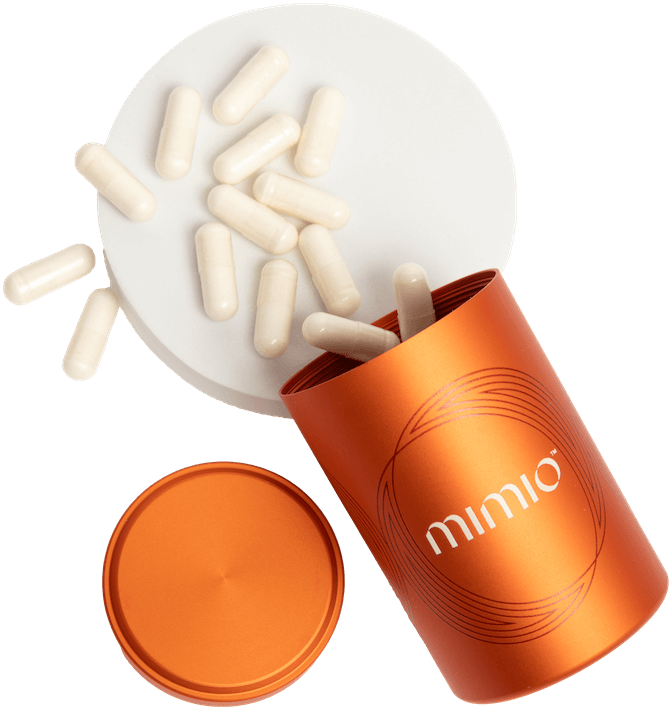Biomimicry might sound like something out of a sci-fi novel—cures that mimic natural healing, tech inspired by plants, products copying biology, and so on—but it’s very real, very now, and very promising. While some trends in health and science fade fast (RIP oxygen bars), biomimicry is proving it’s not just another buzzword. It’s a future-forward way of thinking that’s backed by nature, built by science, and rooted in the idea that the best blueprint for healing might already be inside us.
Let’s break down the importance of biomimicry, what it actually means, and why it’s quietly transforming everything from your skincare to your cells.
What Is Biomimicry, Exactly?
Biomimicry (from bios, meaning life, and mimesis, meaning to imitate) is the science of learning from and mimicking the strategies found in nature to solve human problems. Think Velcro, inspired by plant burrs. Or the shape of wind turbines, modeled after the flippers of humpback whales. But here at Mimio, biomimicry is about studying, decoding, and mimicking the body’s own natural regenerative systems to support energy, health, and longevity.
It’s not about creating something foreign or new. It’s about working with what our natural biology has already perfected.
Why Now? Why Biomimicry?
We’re at an interesting moment in health innovation. People are waking up to the idea that health doesn’t have to come in the form of synthetic fixes or endless prescriptions. Instead, we’re asking: What if we helped the body do what it already knows how to do?
Here’s why biomimicry is taking center stage:
-
The rise of natural health optimization: People want more from their wellness routines—less guesswork, less side effects, and more results.
-
Aging redefined: We’re no longer just fighting age; we’re learning how to age better (and smarter).
-
Science caught up: We now have the tools to decode the body’s own regenerative processes and replicate them.
Biomimicry is like giving your cells a nudge instead of a shove. It's you, but optimized.
Biomimicry in Action: Real-World Health Wins
So what does biomimicry look like in real life? It’s not just a concept—it’s already here. Some examples:
-
Self-cleaning surfaces inspired by lotus leaves (goodbye, germs!)
-
Antibiotics from soil bacteria mimicking natural defense mechanisms
-
Mimetic supplements that replicate the cellular changes seen in fasting, or purposefully skipping meals to kick your bodily functions into overdrive (hi, Mimio)
Let’s talk about that last one for a second. Because fasting, while powerful, isn’t always practical—or pleasant. Mimicking the benefits of fasting at the cellular level? That’s biomimicry at its best.
Biomimicry and Fasting: A Perfect Match
One of the most exciting applications of biomimicry is in metabolic health—especially the benefits we see from fasting.
During a fast, your body triggers a cascade of protective and regenerative processes: autophagy (cell cleanup), increased ketone production, reduced inflammation, and enhanced mitochondrial function¹. These are powerful, science-backed benefits… but you shouldn’t have to starve to get them.
That’s where our biomimetic cell care comes in.
Compounds found in biomimetic supplements (like those found in Mimio) can replicate the biological signature of fasting—without skipping meals. They support natural cell renewal, balance mood and energy, promote healthy metabolism, and help protect against oxidative stress². They help:
-
Support natural cell renewal
-
Balance mood and energy
-
Promote healthy metabolism
-
Protect cells from oxidative stress
This is biomimicry for modern life. Because let’s be real: not everyone wants to intermittently fast their way through brunch.
Nature’s Blueprint = Human Advantage
One of the most compelling reasons biomimicry is more than a fad? Evolution.
Nature has been running trial-and-error experiments for 3.8 billion years. Everything that survives—at the cellular or organism level—does so because it works. So when we borrow ideas from nature, we’re not starting from scratch. We’re reverse-engineering success.
-
Biomimicry = time-tested solutions
-
Science = tools to apply them at scale
-
Health = personalized results based on how your body responds
Think of biomimicry as our special secret sauce for scientific innovation, working from thousands of years of human evolution to accelerate discoveries. A biological roadmap that lets us hack into our body’s built in systems for regeneration and repair so we don’t have to waste time reinventing the wheel.
But Is It Really Backed by Science?
Short answer? Yes. Long answer? Definitely yes.
Biomimetic research deals with molecules that have evolved to work safely and effectively within a human body over ten of thousands of years so there's no messy guesswork involved. Just clean, natural solutions designed to work within your biology. Studies on biomimetic compounds are showing:
-
Improvements in mitochondrial function (read: more cellular energy)³
-
Reduction in markers of chronic inflammation⁴
-
Support for metabolic health, especially in aging populations⁵
-
Neuroprotective benefits linked to fasting-mimicking ingredients⁶
The science behind biomimicry isn’t just compelling—it’s growing. In fact, some researchers now believe biomimetic health interventions could be the future of preventative medicine⁷.
So if it feels like everyone’s suddenly talking about fasting mimetics, cellular care, or regenerative health—it’s because the science is finally catching up to the potential.
Biomimicry vs. Biohacking: Are They the Same?
They’re close cousins, but not twins.
-
Biohacking is about pushing the body to and sometimes past its limits with new tech, routines, or protocols.
-
Biomimicry is about working with your biology, not against it. It’s nature-aligned, not forceful, but still impactful⁸.
Think of biomimicry as the elegant, sustainable version of biohacking. Less Red Bull and blue light blockers, more gentle nudges and cellular whispers, or in other words less brute force, more cellular finesse.
So, Is Biomimicry the Future?
We think so. And we’re not alone.
Big thinkers in wellness, longevity, and regenerative health are leaning into biomimicry as the next wave of innovation. Why?
-
It’s scalable
-
It’s sustainable
-
It’s inherently safe, since it works with natural pathways and molecules
-
It’s designed for real life—not just elite athletes or extreme health enthusiasts
At its core, biomimicry is about trusting the body, and supporting it with what it needs to do its job better.
Not replacing, but enhancing.
Not overriding, but upgrading.
A Natural Approach to a Longer, Healthier Life
If you’re looking to optimize your health, boost your energy, support your cells, and maybe even live a little longer while you’re at it—biomimicry offers a compelling path.
And the best part? You don’t need to be a scientist or a health guru to benefit from it.
You just need to be curious.
TL;DR: Biomimicry, But Make It Simple
-
It’s the science of copying nature’s best tricks
-
It’s already helping us improve health, energy, and longevity
-
It supports the body’s natural regenerative processes
-
It’s not a trend—it’s the foundation of smarter, science-backed wellness
And if you’re ready to see it in action, Mimio Biomimetic Cell Care is a great place to start.
Because nature already gave us the blueprint.
We’re just finally learning how to read it.
References
-
Madeo, F. et al. Caloric Restriction Mimetics: Towards a Molecular Definition. Nat Rev Drug Discov (2014).
-
Brandhorst, S. et al. A Periodic Diet That Mimics Fasting Promotes Multi-System Regeneration. Cell Metabolism (2015).
-
Lopez-Lluch, G. & Navas, P. Calorie Restriction as an Intervention in Ageing. J Physiol (2016).
-
Chung, H.Y. et al. Molecular Inflammation: Underpinnings of Aging and Age-related Disease. Ageing Res Rev (2009).
-
Fontana, L. & Partridge, L. Promoting Health and Longevity through Diet. Nature (2015).
-
Mattson, M.P. et al. Meal Frequency and Timing in Health and Disease. Proc Natl Acad Sci USA (2014).
-
Kennedy, B.K. et al. Geroscience: Linking Aging to Chronic Disease. Cell (2014).
-
Longo, V.D. & Panda, S. Fasting, Circadian Rhythms, and Time-Restricted Feeding in Healthy Lifespan. Cell Metabolism (2016).



